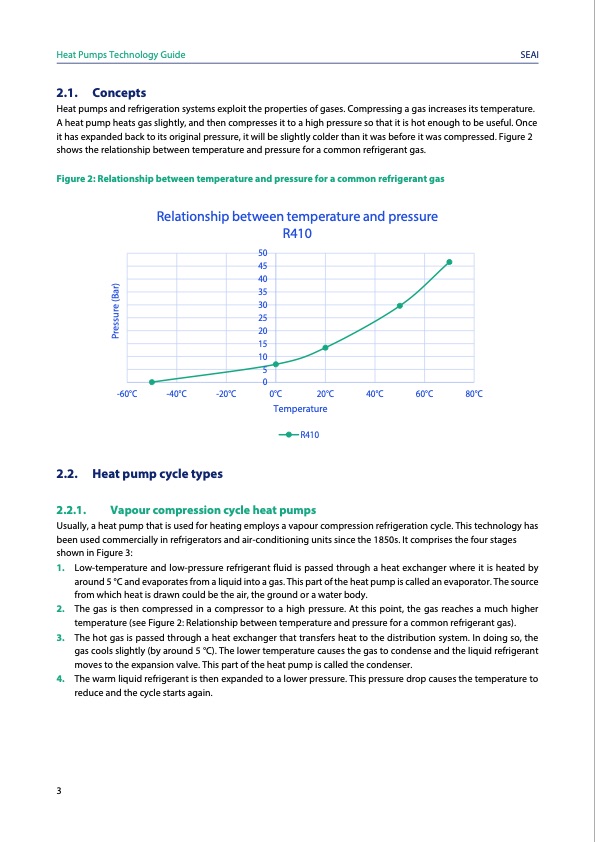
PDF Publication Title:
Text from PDF Page: 007
Heat Pumps Technology Guide SEAI 2.1. Concepts Heat pumps and refrigeration systems exploit the properties of gases. Compressing a gas increases its temperature. A heat pump heats gas slightly, and then compresses it to a high pressure so that it is hot enough to be useful. Once it has expanded back to its original pressure, it will be slightly colder than it was before it was compressed. Figure 2 shows the relationship between temperature and pressure for a common refrigerant gas. Figure 2: Relationship between temperature and pressure for a common refrigerant gas Relationship between temperature and pressure R410 50 45 40 35 30 25 20 15 10 5 0 -60°C -40°C -20°C 0°C Temperature 60°C 80°C R410 20°C 40°C 2.2. Heat pump cycle types 2.2.1. Vapour compression cycle heat pumps Usually, a heat pump that is used for heating employs a vapour compression refrigeration cycle. This technology has been used commercially in refrigerators and air-conditioning units since the 1850s. It comprises the four stages shown in Figure 3: 1. Low-temperature and low-pressure refrigerant fluid is passed through a heat exchanger where it is heated by around 5 °C and evaporates from a liquid into a gas. This part of the heat pump is called an evaporator. The source from which heat is drawn could be the air, the ground or a water body. 2. The gas is then compressed in a compressor to a high pressure. At this point, the gas reaches a much higher temperature (see Figure 2: Relationship between temperature and pressure for a common refrigerant gas). 3. The hot gas is passed through a heat exchanger that transfers heat to the distribution system. In doing so, the gas cools slightly (by around 5 °C). The lower temperature causes the gas to condense and the liquid refrigerant moves to the expansion valve. This part of the heat pump is called the condenser. 4. The warm liquid refrigerant is then expanded to a lower pressure. This pressure drop causes the temperature to reduce and the cycle starts again. 3 Pressure (Bar)PDF Image | Heat Pumps Technology Guide

PDF Search Title:
Heat Pumps Technology GuideOriginal File Name Searched:
Heat-Pump-Technology-Guide.pdfDIY PDF Search: Google It | Yahoo | Bing
CO2 Organic Rankine Cycle Experimenter Platform The supercritical CO2 phase change system is both a heat pump and organic rankine cycle which can be used for those purposes and as a supercritical extractor for advanced subcritical and supercritical extraction technology. Uses include producing nanoparticles, precious metal CO2 extraction, lithium battery recycling, and other applications... More Info
Heat Pumps CO2 ORC Heat Pump System Platform More Info
| CONTACT TEL: 608-238-6001 Email: greg@infinityturbine.com | RSS | AMP |